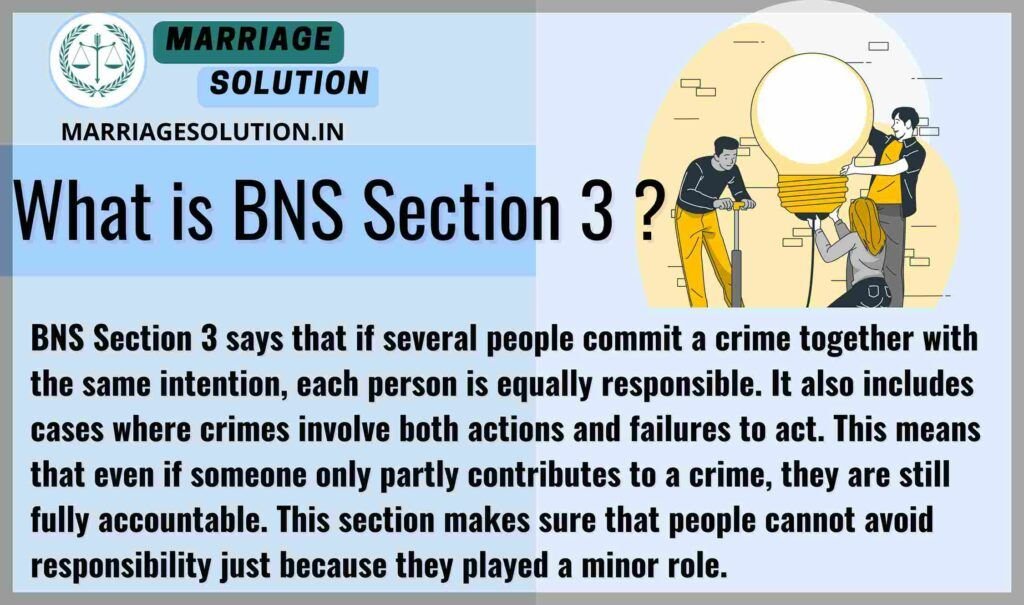Introduction of BNS Section 3
BNS Section 3 explains how people involved in committing a crime together are held responsible. If several people work together to commit a crime, each one is treated as if they committed the act entirely by themselves. This section ensures that everyone who contributes to a crime is accountable, even if their role was minor.
The Bharatiya Nyaya Sanhita (BNS) Section 3 replaces the old Indian Penal Code (IPC) Section 6.

What is Bharatiya Nyaya Sanhita Section 3 ?
BNS Section 3 says that if several people commit a crime together with the same intention, each person is equally responsible. It also includes cases where crimes involve both actions and failures to act. This means that even if someone only partly contributes to a crime, they are still fully accountable. This section makes sure that people cannot avoid responsibility just because they played a minor role.
Section 3 BNS Overview
1. General Exceptions
All definitions of crimes, penalties, and examples in this law must include the exceptions found in the “General Exceptions” chapter, even if not specifically mentioned.
2. Consistency in Terms
Mandating consistent use of terms ensures everyone understands their rights and responsibilities clearly, promoting fairness and transparency.
3.Possession by Related Persons
Recognizing property held by family or employees as the person’s own respects property rights and acknowledges the role of family and close associates.
4.Acts Include Omissions
Including illegal omissions ensures people are held responsible for failing to act when required, protecting others from harm caused by neglect.
5. Joint Liability for Criminal Acts
When several people commit a crime together with a shared intention, each person is responsible for the crime as if they committed it alone.
6. Liability for Crimes with Knowledge or Intention
If a crime is committed because it involves criminal knowledge or intention, everyone involved with that knowledge or intention is liable for the crime as if they committed it alone.
7. Crimes Involving Both Actions and Omissions
When a crime involves causing an effect through both actions and omissions, it is treated as the same offense.
8. Cooperation in Committing Offenses
When a crime involves several acts, anyone who intentionally helps by doing any of those acts, alone or with others, is guilty of the crime.
Examples:
Robbery with Multiple Participants:
C and D plan to rob a bank together. They decide that C will break into the bank at night and D will act as a lookout. Both of them are caught and charged. Even though C did the actual breaking and entering and D was only watching, they are both guilty of robbery because they both intended and participated in the crime.
Neglect by Hospital Staff:
E and F are nurses assigned to care for patient G in a hospital. E and F, intending to harm G, each fail to administer necessary medication. G suffers due to the lack of treatment and dies. Both E and F are guilty of manslaughter because they both contributed to G’s death by neglecting their duties.
Neglect without Direct Cooperation:
E, a nurse, stops giving G their medication, intending to cause harm. G’s condition worsens, but E is soon replaced by F. F, knowing the medication is still needed, also neglects G. G eventually dies from the lack of care. F is guilty of manslaughter, but E is only guilty of an attempt to commit manslaughter because E did not cooperate directly with F.
9. Different Offenses for the Same Criminal Act
When several people are involved in committing a criminal act, they can be guilty of different offenses based on their involvement.
BNS Section 3
What does BNS Section 3 state about collective criminal acts?
When a criminal act is done by several persons with a common intention, each person is liable as if they committed the act alone.
How does BNS Section 3(6) address criminal knowledge or intention?
If several persons perform an act that is criminal due to their knowledge or intention, each person is liable for the act as if they did it alone.
What is the significance of actions and omissions in BNS Section 3(7)?
Conclusion
BNS Section 3 strengthens accountability in criminal law by ensuring that joint acts, omissions, and cooperation in crimes are punished equally. Unlike the old IPC Section 6, this provision gives clearer rules for group liability and makes sure no offender can escape responsibility by playing only a “minor role.”
Need Legal Support?
If you are dealing with court cases, marriage problems, or any other legal issue, our team at Marriage Solution – Lawyer Help is here for you. Simply fill out our quick online enquiry form, and we’ll connect you with the right legal expert to support your needs.
Read Next — Related BNS Sections
Finished with BNS Section 3? Continue exploring the next provisions of the Bharatiya Nyaya Sanhita (BNS), 2023. Each section includes explanations, examples, and plain-language breakdowns for easy understanding.
BNS Chapter II – Of Punishments
BNS Section 4 : Punishments.
https://marriagesolution.in/bns_section/bns-section-4/
BNS Section 5 : Commutation of sentence of death or imprisonment for life.
https://marriagesolution.in/bns_section/bns-section-5/
BNS Section 6 : Fractions of terms of punishment.
https://marriagesolution.in/bns_section/bns-section-6/
BNS Section 7 : Sentence may be (in certain cases of imprisonment) wholly or partly rigorous or simple.
https://marriagesolution.in/bns_section/bns-section-7/
BNS Section 8 : Amount of fine, liability in default of payment of fine, etc.
https://marriagesolution.in/bns_section/bns-section-8/
Explore More
Full BNSS Section List
https://marriagesolution.in/bnss_section-list
Full IPC Section List
https://marriagesolution.in/ipc-section-list
Full Indian Law & Blogs
https://marriagesolution.in/indian-law/
